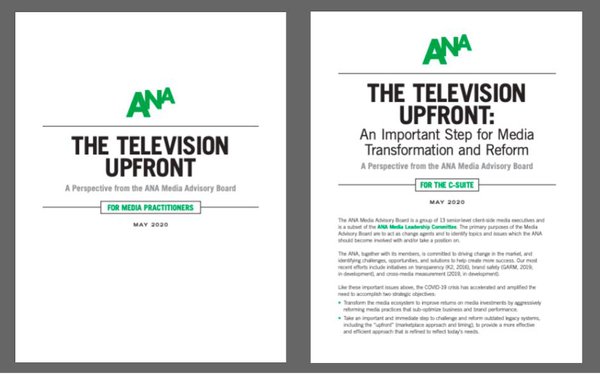
A day after calling for “sweeping changes”
to transform the ad industry’s inclusiveness and diversity, the Association of National Advertisers this morning issued another call for “sweeping changes” in the “media
ecosystem,” and specifically called on the television advertising industry to move the annual upfront negotiating season from a spring/early summer marketplace purchasing a fourth quarter
through third quarter broadcast year to a fall/winter marketplace purchasing a conventional calendar year.
Other than the shift in the timing of negotiations and the quarters
represented in upfront deals, the ANA implied that nothing else should change about the upfront process.
advertisement
advertisement
“This should not change the all-year negotiating process that currently
exists between buyers and sellers. Nor should it change the fundamentals of marketplace transactions, with each company making its own independent determination of when and what advertising time it
will purchase,” the ANA said in its statement, adding: “Rather, it should be part of a process that is grounded in flexibility and includes, as a choice, a better-timed upfront.”
The ANA also released two white papers with the call to educate both media buyers and C-level marketers about the
process and why it's important to change the market timing now.
“The calendar year upfront is a modification of the legacy broadcast year upfront where the same general principles
apply – advertising bought and sold in advance,” notes one of the papers, adding: "However, the time frame is shifted to purchase inventory in a specific calendar year upfront with the
typical negotiation window occurring in the fall or early winter timeframe.”
The call creates further uncertainty for an upfront advertising season that already has been transformed in terms
of its presentations -- which moved from physical events to virtual ones -- and to its timing, which many buyers had already been predicting would shift to the fall or winter.
But in recent
weeks, network sales organizations have indicated they are ready to do business as usual, and some have implied they already have negotiations underway. Such posturing is typical for the sell-side,
which tries to create momentum for negotiations in order to stampede the market and create perceived demand for its upfront inventory.
While the ANA call did not outline any other specific
sweeping changes, it alluded to them.
“Timing is only one of the choices marketers make," ANA Chairman and P&G Chief Brand Officer Marc Pritchard said in a statement, adding:
"We need far greater marketplace transparency throughout the media system to enable choices to drive out media waste, improve effectiveness, and dramatically elevate the consumer experience. Only then
can we achieve true media transformation and reform.”
He cited several "embryonic initiatives that can revolutionize the industry," including:
- The WFA/ANA collaboration to
drive global advances in cross platform measurement.
- The Global Alliance for Responsible Media (GARM) to eliminate harmful content online and alleviate brand safety
concerns.
- Privacy for America, which is focused on creating national privacy legislation through the development of one common standard among all states.
- An industry effort to address the transition to a digital ecosystem without third-party cookies.